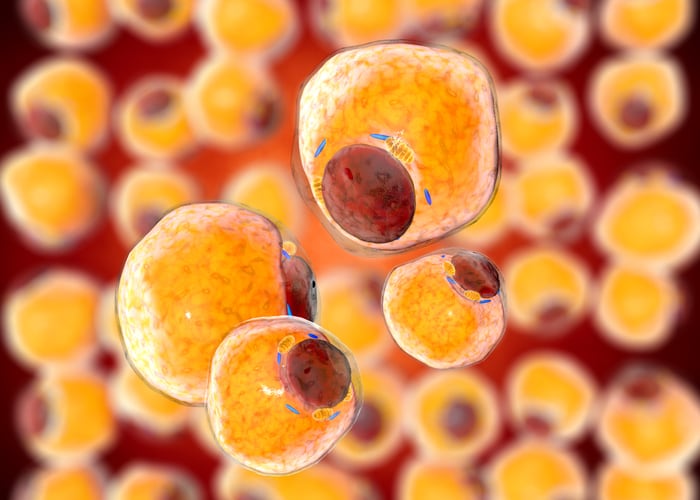One of the common features of obesity and ageing is the accumulation of senescence (the process of loss of power for division and growth in cells, otherwise known as biological ageing) of visceral tissue.
The clinical trial conducted by authors from Iran, set out to investigate the effects of NAC on obesity complications and senescence of visceral adipose tissue, in obese adults.
Results showed that intervention with NAC significantly reduced markers of senescence, the expression of the p16 tumour suppressor protein, and interleukin 6 (IL-6) genes in the visceral adipose tissue, a hormonally active component of total body fat, compared to placebo in obese adults for 4 weeks.
Compounds that can selectively induce apoptosis, or programmed cell death, in senescent cells are known as senolytics.
This was the first human study to investigate the effects of NAC administration on senescence and factors associated with metabolic disorders in obese subjects.
The authors conclude: “NAC, in addition to having a potential beneficial effect on reducing some of the complications caused by obesity, seems to have synolytic/senomorphic potential as well.”
Significance
Numerous studies have found a connection between obesity and higher levels of oxidative stress, which causes DNA damage.
When DNA is broken, a series of molecules in the DNA damage response pathway is activated, leading to the p53 tumour suppressor protein activation.
Depending on the type and amount of cell stress, p53 can have several responses, including growth arrest, apoptosis, or senescence.
Senescence-associated secretory phenotype (SASP) is a major tissue function impairment caused by the increase of senescent cells.
The primary source of sterile inflammation in the adipocytes of obese people is the secretory phase of senescent cells, and this mild to moderate inflammation can also contribute to insulin resistance and other metabolic problems.
Inflammation and insulin resistance are among the most important mechanisms mentioned for the body’s resistance to low-calorie diets for weight loss in individuals with obesity.
Recently, the use of synolytic/senomorphic drugs and antioxidant supplements has been considered to investigate their senescence activity.
One of these is NAC, a sulfur-containing amino acid derived from acetylated cysteine.
Previous research has shown an increase in antioxidants and a reduction of free radicals following the administration of this drug.
Increasingly, the role of NAC in improving insulin secretion following the regulation of its receptor activity, reducing fat tissue, preventing and improving endothelial damage and ischemia, inhibiting phospholipid metabolism, and regulating the process of releasing pro-inflammatory cytokines has been noted.
In addition, it has been shown that NAC can effectively improve insulin resistance and reduce the secretion of factors effective in inflammation.
One study showed that NAC attenuated senescence and reduced kidney fibrosis through the activation of sirtuin1(SIRT1) and deacetylation of p53.
Therefore the aim of the current study was to investigate the effects of NAC on anthropometric indices, inflammatory factors, insulin resistance, and senescence of visceral adipose tissue in obese adults.
The study
The randomised clinical trial was conducted during the years 2022–2023, with 40 adult obese participants (aged 25–50 years, BMI ≥ 35 kg/m2).
Participants were randomly assigned to receive 600 mg of NAC (n = 20) or placebo as a control (n = 20) for 4 weeks.
Main measures were: SA-β-gal activity test, changes in the expression of the genes for tumour necrosis factor (TNF-α), IL-6, and p16, and blood concentrations of TNF-α and IL-6.
Anthropometric factors were measured before and after the study.
During bariatric surgery, visceral adipose tissue was used to examine gene expression and senescence cells.
Results suggest that intervention with NAC significantly reduces SA-β-gal activity.
The level of IL-6 (P 0.014; fold change: 0.02) and P16 (P 0.047; fold change: 0.23) gene expression in the intervention group was significantly lower than the control group.
In addition, findings showed the potential and beneficial effect of NAC administration on reducing the levels of inflammatory factors including IL-6 and high-sensitivity C-reactive protein (hs-CRP), as well as the level of fasting blood sugar (FBS), homeostatic model assessment of insulin resistance (HOMA-IR), and insulin compared to placebo after adjusting for confounders.
The authors conclude: “Although the purpose of this study was mostly focused on reducing the complications caused by obesity, according to our findings, it seems that this drug can have synolytic/senomorphic potential as well.”
They do however note some limitations, namely that they included no assessment of obesity-related hormones and body fat percentage due to budget constraints.
They also add senescence in adipose tissue is evaluated globally by the SA-gal test, but it has been previously suggested that more research is required to identify the many senescent cell types that are present in adipose tissue by combining the labelling of senescence markers identity.
Journal: Frontiers in Nutrition
https://www.frontiersin.org/articles/10.3389/fnut.2023.1237869/full
“Effects of N-acetylcysteine on aging cell and obesity complications in obese adults: a randomized, double-blind clinical trial.”
Authors: Mohammad Hassan Sohouli, Ghazaleh Eslamian, Nasser Malekpour Alamdari, Maryam Abbasi, Sepideh Fazeli Taherian, Diba Behtaj, and Hamid Zand.


